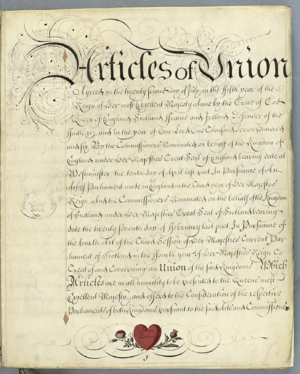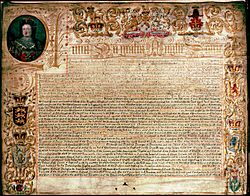Treaty of Union facts for kids
The Treaty of Union is a very important agreement. It created a new country called Great Britain. This happened when the Kingdom of England (which included Wales) and the Kingdom of Scotland joined together. People at the time often called it the Articles of Union.
The details of this treaty were agreed on July 22, 1706. After that, both the English Parliament and the Scottish Parliament passed their own laws, called Acts of Union. These laws made the agreement official. The new country, Great Britain, officially began on May 1, 1707.
Contents
Why Did the Union Happen?
A New King for Two Kingdoms
In 1603, Queen Elizabeth I of England died without children. The throne then went to her cousin, James VI of Scotland. He became King James I of England and Ireland. This meant one king ruled both Scotland and England. This was called a personal union. It helped calm England's worries about Scotland joining with France to attack England.
King James I and VI wanted to join Scotland and England into one country. He called it "Great Britain." But attempts to do this failed in 1606, 1667, and 1689.
Scotland's Big Financial Problem
In 1698, a Scottish company tried to set up a trading colony. This was called the Darien scheme. It was in Panama, a narrow strip of land connecting North and South America. Scots invested a huge amount of money in this plan. It was about a quarter of all the money in Scotland at the time!
However, English businesses didn't like the idea. They didn't want competition. Also, England was at war with France. So, King William III of England (who was also King William II of Scotland) didn't fully support the Scottish plan. Spain also claimed the land in Panama.
English companies even threatened legal action. This forced investors from other countries to pull out. The Scottish colony failed. Most colonists died from tropical diseases. This was a huge financial disaster for Scotland. It made many powerful Scots more open to the idea of joining with England. Even though many ordinary Scots were against it, the idea of union gained support.
Queen Anne's Goal
Queen Anne became queen of both England and Scotland in 1702. She strongly wanted to unite the two kingdoms. In 1705, with her support, the parliaments of England and Scotland agreed to talk about a union again.
How the Treaty Was Negotiated
Choosing the Negotiators
Both England and Scotland agreed to choose 31 people each. These people would be "commissioners" to negotiate the treaty. The Scottish Parliament first planned to elect their commissioners. But then, the Duke of Hamilton suggested the Queen should choose them. This was agreed. In Scotland, the Duke of Queensberry and the Duke of Argyll mostly advised the Queen on who to pick.
Most of the Scottish commissioners supported the union. Only one, George Lockhart of Carnwath, was against it. The English commissioners included important government officials. Most English politicians who supported the union were from the Whig party.
The Negotiation Process
The talks began on April 16, 1706, in London. The commissioners didn't talk face-to-face. Instead, they worked in separate rooms. They sent their ideas and responses to each other in writing. News about the talks was kept secret.
Both sides had specific goals. Within a few days, England got a promise that the House of Hanover family would become the next rulers of Scotland after Queen Anne. Scotland, in return, was promised access to colonial markets. This meant Scottish traders could trade freely in English colonies, just like English traders.
Making it Official
The negotiations finished on July 22, 1706. Then, both parliaments wrote laws to make the agreement happen. Many Scots who supported the union believed that if they didn't agree, England would force a union on them anyway. English troops were even stationed near the Scottish border.
There were fierce debates in both countries. In Scotland, some debates led to public unrest. Many ordinary Scots were very unhappy about the idea of a union. There was even talk of an uprising. However, the treaty was signed. The documents were quickly sent south with a military escort.
On May 1, 1707, the Kingdom of Great Britain was born. The parliaments of Scotland and England had approved the Acts of Union. These acts combined the two parliaments and the powers of the two crowns. Scotland's crown, sceptre, and sword of state stayed in Edinburgh Castle. Queen Anne became the first ruler of the united Great Britain. Scotland sent 45 members to the new House of Commons of Great Britain. They also sent representative peers to the House of Lords.
Some Scottish politicians received money for their support. The famous poet Robert Burns later wrote about this, saying Scotland was "bought and sold for English gold." However, many historians today say the vote was fair.
Key Points of the Treaty
The Treaty of Union had 25 main points, called Articles. Here are some of the most important ones:
- Article 1: Stated that England and Scotland would become one kingdom. It would be called Great Britain. It would have its own royal coat of arms and a flag combining the crosses of St Andrew (Scotland) and St George (England).
- Article 2: Said that the House of Hanover family would rule Great Britain. It also made sure that only a Protestant ruler could take the throne, following the English Act of Settlement of 1701.
- Article 3: Created one unified Parliament of Great Britain.
- Article 4: Gave everyone in Great Britain freedom to trade and travel within the new kingdom and its colonies.
- Articles 5 to 15, 17, and 18: Covered things like trading ships, taxes, weights and measures, and trade rules. This was to make sure everyone in the new kingdom was treated equally.
- Article 16: Required Great Britain to have a common currency. This led to new Scottish coins being made between 1707 and 1710. Scotland also kept its own Mint.
- Article 19: Ensured that Scotland would keep its own legal system. This included the Court of Session and the High Court of Justiciary.
- Article 22: Stated how Scotland would be represented in the new Parliament. Scotland would send 16 representative peers to the House of Lords and 45 members to the House of Commons.
- Article 24: Created a new Great Seal of Great Britain. This seal is used to make official documents valid. It also said that important Scottish records, like those from the Parliament of Scotland, would stay in Scotland.
- Article 25: Declared that any laws in either kingdom that went against the Treaty would no longer be valid.
Commissioners Who Negotiated the Treaty
These are the people who were chosen to negotiate the Treaty of Union:
Kingdom of England
- William Cowper, 1st Baron Cowper, Lord Keeper of the Great Seal
- Sidney Godolphin, 1st Earl of Godolphin, Lord High Treasurer
- Thomas Herbert, 8th Earl of Pembroke, Lord President of the Council
- John Holles, 1st Duke of Newcastle, Lord Privy Seal
- Henry Boyle, Chancellor of the Exchequer
- Sir Charles Hedges, Secretary of State for the Southern Department
- Robert Harley, Secretary of State for the Northern Department
- Charles Paulet, 2nd Duke of Bolton
- Thomas Tenison, Archbishop of Canterbury
- Charles Howard, 3rd Earl of Carlisle
- Sir John Cooke, Advocate-General
- John Manners, Marquess of Granby
- Sir Simon Harcourt, Solicitor General
- Charles Montagu, 1st Baron Halifax
- William Cavendish, Marquess of Hartington
- Sir John Holt, Lord Chief Justice
- Evelyn Pierrepont, 5th Earl of Kingston-upon-Hull
- Sir Edward Northey, Attorney General
- Ralph Grey, 4th Baron Grey of Werke
- Edward Russell, 1st Earl of Orford
- Lord William Powlett, Member of Parliament for Winchester
- John Smith, Speaker of the House of Commons
- John Somers, 1st Baron Somers
- Charles Seymour, 6th Duke of Somerset
- Charles Spencer, 3rd Earl of Sunderland
- Charles Townshend, 2nd Viscount Townshend
- Sir Thomas Trevor, Chief Justice of the Common Pleas
- Dr. Stephen Waller, Doctor of Law
- Thomas Wharton, 5th Baron Wharton
- Charles Powlett, Marquess of Winchester
- John Sharp, Archbishop of York
Kingdom of Scotland
- James Ogilvy, 1st Earl of Seafield, Lord Chancellor
- James Douglas, 2nd Duke of Queensberry, Lord Privy Seal
- John Erskine, Earl of Mar, Secretary of State
- Hugh Campbell, 3rd Earl of Loudoun, Secretary of State
- David Boyle, 1st Earl of Glasgow, Treasurer-depute
- Lord Archibald Campbell
- Daniel Campbell of Shawfield, Commissioner for Inveraray
- John Clerk of Penicuik, Commissioner for Whithorn
- Adam Cockburn, Lord Ormiston, Lord Justice Clerk
- Sir David Dalrymple of Hailes, 1st Baronet, Commissioner for Culross
- Hew Dalrymple, Lord North Berwick, Lord President of the Court of Session and Commissioner for North Berwick
- Robert Dundas, Lord Arniston, Commissioner for Edinburghshire
- Thomas Hay, Viscount Dupplin
- Alexander Grant of that Ilk, Commissioner for Inverness-shire
- Sir Patrick Johnston, Commissioner for Edinburgh
- David Melville, 3rd Earl of Leven
- George Lockhart of Carnwath, Commissioner for Lanarkshire
- Francis Montgomerie of Giffen, Commissioner for the Treasury and Commissioner for Ayrshire
- Hugh Montgomerie of Busbie, Commissioner for Glasgow
- William Morrison of Prestongrange, Commissioner for Peeblesshire
- James Douglas, 11th Earl of Morton
- Sir Alexander Ogilvy of Forglen, 1st Baronet, Commissioner for Banff
- Archibald Primrose, 1st Earl of Rosebery
- William Ross, 12th Lord Ross, Commissioner for the Treasury
- William Seton of Pittmedden, Commissioner for Aberdeenshire
- Sir James Smollett of Stainflett and Bonhill, Commissioner for Dumbarton
- John Dalrymple, 1st Earl of Stair
- Dougald Stewart of Blairhill, Commissioner for Rothesay
- Robert Stewart of Tillicoultry, Commissioner for Bute
- John Gordon, 16th Earl of Sutherland
- David Wemyss, 4th Earl of Wemyss




